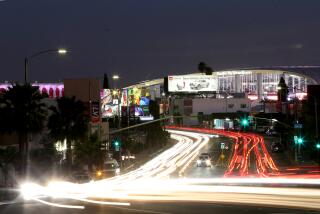5-Year Transit Program Adopted for San Diego
- Share via
San Diego’s transit riders can look forward to a modest increase in bus service in the next five years and a better scheduling system that will make it easier to get where they want to go, according to a regional transit plan adopted Thursday by the Metropolitan Transit Development Board.
The short-range priorities call for completion of the downtown San Diego-to-El Cajon trolley line, the opening of a trolley line to the not-yet-built bayside convention center on Harbor Drive, and dozens of bus line improvements.
Probably the most helpful advance in public transit will be better coordination of the county’s half-dozen transit system schedules to mesh at regional transit centers where bus lines--and eventually trolleys--will merge from all directions. Increases in the frequency of bus service are expected to boost transit ridership at a rate greater than the area’s population growth as more efficient bus service gains new riders. MTDB planners estimate a 23% jump in ridership by 1991.
However, all the rosy forecasts of more and better transit service are based on passage of a half-cent local sales tax by voters in November, 1987. Without the sales tax revenue for local streets and roads, state highways and public transit systems, MTDB planners anticipate that no new projects can be funded except for extension of the San Diego Trolley route eastward to El Cajon.
In fact, the MTDB five-year spending program anticipates that, without the sales tax revenue, deficits would occur in the next five years even to operate the current level of transit service. A reduction in bus service, an increase in fares or a new source of funds is needed to finance even a “status quo” public transit system.
Roger Snoble, manager of San Diego Transit Corp., said the bus system plans “modest” expenditures that will result in substantially improved service for transit riders throughout the southern and eastern portions of the county.
San Diego Transit, which was forced to cut out much of its low-ridership night and weekend service after Proposition 13 put a lid on property tax levies in 1978, will emerge with a “far superior system” of public transportation to the pre-Proposition 13 bus service, he said.
Emphasis, however, will be placed on high-ridership routes and on improving peak-hour service because of the transit firm’s top priority: increasing bus ridership during commuting hours in order to ease the automobile traffic crunch on the region’s highways.
Snoble said that studies are aimed at the areas of most rapid growth--the Golden Triangle east of La Jolla and North City West, the Interstate 15 corridor where new communities are springing up along 20 miles of the North City and North County freeway. Also on the study agenda is completion of an intensive survey of downtown San Diego traffic to remove the congestion that impedes transit vehicles and autos alike.
The major capital expenditures of the next five years are programmed for the San Diego Trolley.
- The East Line extension from Euclid Avenue in Southeast San Diego to El Cajon, including 10 air-conditioned trolley cars, will cost $87 million. The scheduled start of service is early 1989.
- The Bayside Line, a 1.3-mile route along San Diego Bay to serve hotels and the proposed convention center, will cost $15 million to $20 million. Service is expected to coincide with the opening of the convention center in mid-1989.
- Commencement of the trolley extension to Old Town from downtown San Diego and extension of the East Line trolley from El Cajon to Santee. The start of both construction projects is scheduled for 1989-90.
- Completion of the E Street trolley station in Chula Vista. It is expected to open late this year.
Capital expenditures for bus systems include several new transit centers similar to the one being built at San Diego State University. Proposed sites are Pacific Beach, Plaza Bonita in National City and Kearny Mesa.
The only reduction in service proposed is the consolidation of Route 32 with a private bus service (Amarillo y Rosa) from the Mexican border to downtown San Diego, resulting in a $1-million-a-year savings.
Sales tax revenue from the November, 1987, election is programmed into the transit budget starting in mid-1988 at an initial level of about $5 million a year.
Some of the proposed bus service improvements that the local sales tax funds may finance are:
- Night bus service to La Mesa and San Diego State University.
- Express bus service from North City West and from Scripps Ranch to downtown San Diego.
- Extended hours for bus service in Imperial Beach.
- Improved peak-hour frequency of bus service at North Island Naval Air Station.
- New routes and increased bus service in virtually every part of South and East County.
More to Read
Sign up for Essential California
The most important California stories and recommendations in your inbox every morning.
You may occasionally receive promotional content from the Los Angeles Times.













